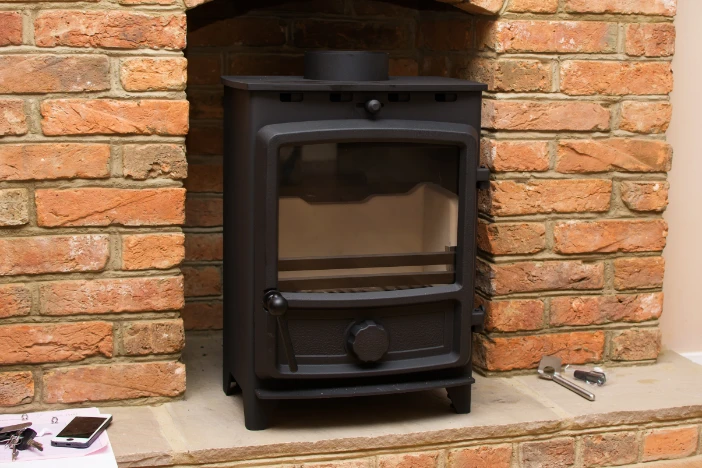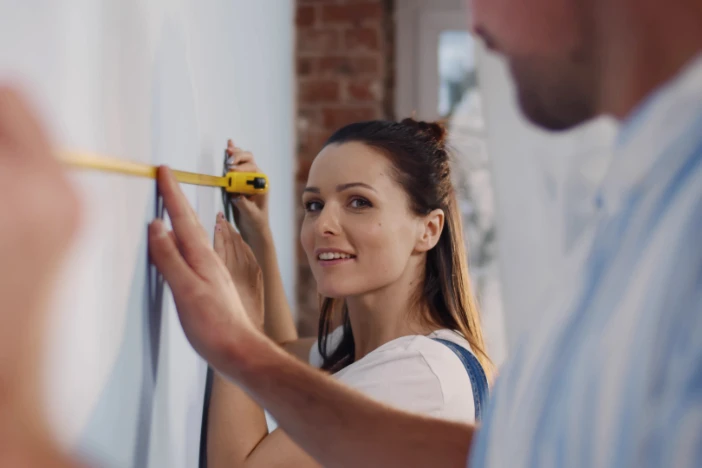
What’s the appropriate size fireplace insert for your space?
Now that you’ve settled on a particular fuel, you’re ready to figure out just how big an insert you need. Choosing the right size of a fireplace insert is crucial to ensure it can efficiently heat your home without wasting energy. To determine the appropriate size, you need to consider several factors:
- Dimensions of the room or setting you plan to heat
- The room or area’s insulation level
- Dimensions of your existing fireplace or available wall space
- The climate in your area

Determine the BTUs needed to heat your space
One useful metric when sizing a fireplace insert is its heating capacity, measured in British Thermal Units (BTUs). A rule of thumb is that for every square foot of space in the room, you need around 20-30 BTUs. For example, if you have a 1,000 ft2 living room, you need an insert with at least 20,000-30,000 BTU output.
The efficiency rating of an insert is related to its heat output. The higher the efficiency rating, the more heat it will produce using less fuel. Look for models certified by organizations such as the Environmental Protection Agency (EPA) or industry groups like the Hearth Patio Barbecue Association (HPBA).
Assess the space’s ability to hold heat
Rooms with thin walls, lots of windows and little insulation will lose heat quicker than those with the opposite characteristics. Similarly, outdoor settings (especially uncovered ones) will lose a lot of heat as the heat rises and spreads outside the main area. Consequently, you’ll need inserts with higher capacities to maintain the temperature.
Measure your installation site
Before purchasing a fireplace insert, it’s crucial to correctly measure your existing fireplace or available wall space to find an insert that fits properly. An estimate may be okay to start but you don’t want to leave anything to chance.
Existing fireplace
Start by measuring the height and width of the fireplace opening at its widest point (usually near the bottom). Then measure the depth from front to back inside the fireplace (the distance between the firebox and where it meets the front of the fireplace).
In addition to these measurements, you should measure your fireplace’s back wall, hearth and mantle height to get a sense of how much a gap you may need to account for if you want to create a seamless look that blends with your existing decor style and color palette.

Usable wall area
Measuring your wall for ventless fireplace inserts or ones that don’t need a chimney may seem like a no-brainer. It’s just a wall, right? How hard can that be? Actually, it’s a lot more complicated than you think.
Sure, you may have a huge 8 by 5 foot space on drywall facing your living room or outdoor lounge but how thick is it and what’s inside? You typically think of the facade of a fireplace insert but it has depth that needs to be accounted for and supported. What about electrical lines and piping in the walls? Where are the studs and framework needed to form part of the framing support for the insert?
Understanding blueprints and design schematics is critical when planning a fireplace insert installation.
If you feel unsure of your measuring abilities, consider hiring a professional installer to come out and do it for you or guide you through the process. Incorrect measurements could cause irreversible damage during installation that can be costly in both time and money. Ask questions early to avoid a problem later on. Their business depends on an up-to-date knowledge of legal and safety requirements for many residential and commercial properties, so lean on them.
Think of measuring your fireplace or wall like measuring yourself for clothes – the right measurements make all the difference in finding something that fits well and looks great. It may take some effort to get these measurements right, but doing so will make all the difference in choosing an insert that works perfectly for your patio or bedroom.
Consider your climate
If you live in a temperate zone where it gets cool but not too cold, then you probably don’t need to raise the temperature much. Conversely, Northern areas and low and high altitudes can experience frigid winters and dramatic drops in temperature at night. These climates require more heat to stave off the cold.

Safety codes & installation
Lastly, even if you’ve diligently done your homework, there are always regulations, building codes and ordinances that govern home upgrades. They vary by locale and are continually updated. Once you’re comfortable you know what you want and need to meet your objectives for the setting, it’s best to consult with a professional installer familiar with local codes and requirements. They can assess your home, confirm your choice or recommend a model that matches your heating needs and fits your budget.
Installing fireplace inserts is easier than building a traditional brick or stone fireplace from scratch but it’s not for the casual DIY craftsman. An installation error that results in poor aesthetics is one thing. Improperly securing or connecting a fireplace that becomes a fire hazard that could destroy your property and put lives at risk is another. Play it safe and hire a professional or two to do the job right and safely.
Ready to enjoy the ambiance & warmth of a fireplace insert
Congratulations on your due diligence in identifying the right fireplace insert for your home. Your effort will be rewarded with a fire feature that enhances the atmosphere and comfort of your setting. It’s a wise investment that comes with responsibilities but is worth it. Check out our fireplace inserts at Decor Outdoor. The Flex Fireplace from EcoSmart Fire is a bio-ethanol burning insert that can be customized to fit any setting indoors and outdoors.





Leave a Reply